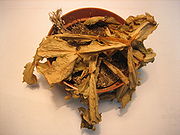
Permanent wilting point
Encyclopedia

Water content
Water content or moisture content is the quantity of water contained in a material, such as soil , rock, ceramics, fruit, or wood. Water content is used in a wide range of scientific and technical areas, and is expressed as a ratio, which can range from 0 to the value of the materials' porosity at...
at −1500 J/kg (or −15 bars
Bar (unit)
The bar is a unit of pressure equal to 100 kilopascals, and roughly equal to the atmospheric pressure on Earth at sea level. Other units derived from the bar are the megabar , kilobar , decibar , centibar , and millibar...
) of suction pressure, or negative hydraulic head
Hydraulic head
Hydraulic head or piezometric head is a specific measurement of water pressure above a geodetic datum. It is usually measured as a water surface elevation, expressed in units of length, at the entrance of a piezometer...
.
However, it is noted that the PWP values under field conditions are not constant for any given soil, but are determined by the integrated effects of plant, soil and atmospheric conditions.
History
The concept was introduced in the early 1910s. Lyman Briggs and Homer LeRoy Shantz (1912) proposed the wilting coefficient, which is defined as the percentage water content of a soil when the plants growing in that soil are first reduced to a wilted condition from which they cannot recover in approximately saturated atmosphere without the addition of water to the soil (Taiz and Zeige, 1991). See pedotransfer functionPedotransfer function
Pedotransfer function is a term used in soil science literature, which can be defined as predictive functions of certain soil properties from other more available, easily, routinely, or cheaply measured properties...
for wilting coefficient by Briggs.
Frank Veihmeyer and Arthur Hendrickson from University of California-Davis
University of California, Davis
The University of California, Davis is a public teaching and research university established in 1905 and located in Davis, California, USA. Spanning over , the campus is the largest within the University of California system and third largest by enrollment...
found that it is a constant (characteristic) of the soil and is independent of environmental conditions. Lorenzo A. Richards
Lorenzo A. Richards
Lorenzo Adolph Richards or known as Ren was one of the 20th century’s most influential minds in the field of soil physics. Richards was born on April 24, 1904, in the town of Fielding, Utah, and received a B.S. and M.A. degree in Physics from Utah State University...
proposed it is taken as the water content at −1500 J/kg.
See also
- Available water capacityAvailable water capacityAvailable water capacity or available water content is the range of available water that can be stored in soil and be available for growing crops....
- EcohydrologyEcohydrologyEcohydrology is an interdisciplinary field studying the interactions between water and ecosystems. These interactions may take place within water bodies, such as rivers and lakes, or on land, in forests, deserts, and other terrestrial ecosystems...
- Field capacityField capacityField capacity is the amount of soil moisture or water content held in soil after excess water has drained away and the rate of downward movement has materially decreased, which usually takes place within 2–3 days after a rain or irrigation in pervious soils of uniform structure and texture...
- Moisture equivalentMoisture equivalentMoisture equivalent is proposed by Lyman Briggs and McLane as a measure of field capacity for fine-textured soil materials.Moisture equivalent is defined as the percentage of water which a soil can retain in opposition to a centrifugal force 1000 times that of gravity...
- Moisture stressMoisture stressMoisture stress occurs when the water in a plant's cells is reduced to less than normal levels. This can occur because of a lack of water in the plant's root zone, higher rates of transpiration than the rate of moisture uptake by the roots, for example, because of an inability to absorb water due...
- Nonlimiting water rangeNonlimiting water rangeThe Non-limiting water range represents the range of water content in the soil where limitations to plant growth are minimal...
- Soil plant atmosphere continuumSoil plant atmosphere continuumThe Soil-Plant-Atmosphere Continuum is the pathway for water moving from soil through plants to the atmosphere.The transport of water along this pathway occurs in components, variously defined among scientific disciplines:...

